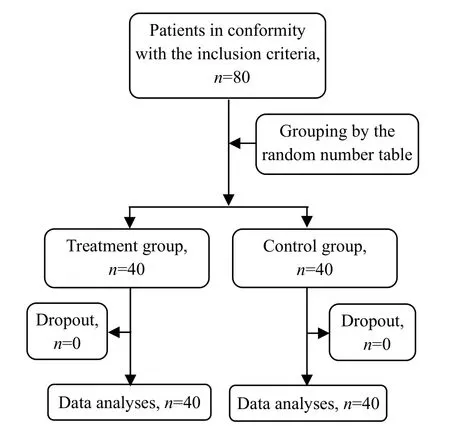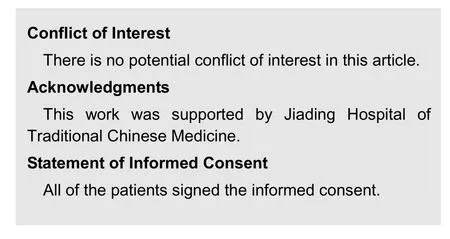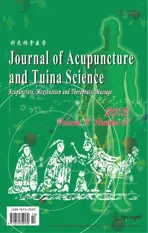Clinical Study on Moxibustion at Shenque (CV 8) for Chronic Urticaria
2013-07-18WangYingjieChaiWeihanWangHairuiWuZongqin
Wang Ying-jie, Chai Wei-han, Wang Hai-rui, Wu Zong-qin
Dermatology Department, Jiading Hospital of Traditional Chinese Medicine, Shanghai 201800, China
Clinical Study on Moxibustion at Shenque (CV 8) for Chronic Urticaria
Wang Ying-jie, Chai Wei-han, Wang Hai-rui, Wu Zong-qin
Dermatology Department, Jiading Hospital of Traditional Chinese Medicine, Shanghai 201800, China
Objective: To observe the safety and efficacy of moxibustion at Shenque (CV 8) for chronic urticaria.
Methods: A total of 80 cases who met the inclusion criteria were randomly allocated into a treatment group and a control group, 40 in each. Cases in the treatment group were treated with thunder-fire moxibustion at Shenque (CV 8), whereas cases in the control group were treated with Mizolastine. Changes in clinical symptoms such as itching and skin lesion were observed before and after treatment and the therapeutic efficacies were assessed.
Results: After treatment, the total scores of clinical symptoms in both groups were markedly reduced (P<0.05), and the reduction was more significant in the treatment group than that in the control group (P<0.05). The total effective rate in the treatment group was 77.5%, versus 65.0% in the control group, showing no significant difference (P>0.05). TheRiditanalysis showed a between-group significant difference in therapeutic efficacy grades (P<0.05). There were no reports of adverse reactions in the treatment group and 2 cases experienced mild somnolence in the control group.
Conclusion: With an exact effect for chronic urticaria, moxibustion at Shenque (CV 8) obtained better results in overall efficacy and improving symptoms than oral administration of Mizolastine.
Moxibustion Therapy; Moxa Stick Moxibustion; Point, Shenque (CV 8); Urticaria
Chronic urticaria is a common skin condition in dermatology department. It is known as ‘yin zhen (urticaria)’ in traditional Chinese medicine (TCM). The itching caused by urticaria can severely affect the patients’ life and work. We’ve treated this condition with moxibustion at Shenque (CV 8) and compared it with oral administration of Mizolastine. The results are now summarized as follows.
1 Clinical Materials
1.1 Diagnostic criteria
1.1.1 Diagnostic criteria in Western medicine
This is made according to theDiagnostic Criteria for Clinical Disease & Cure and Improvement: Sudden occurrence of pale or bright red wheals in various sizes and shapes in the skin, the wheals can gradually become clustered; lasting ≤24 h; duration ≥6 weeks.
1.1.2 Diagnostic criteria in TCM
This is made according to diagnostic basis for urticaria due to wind-cold in theCriteria of Diagnosis and Therapeutic Effects of Diseases and Syndromes in Traditional Chinese Medicine: Sudden occurrence of edematous lesions with clear borders; the wheals come and go, causing severe itching but leaving no marks behind; wheals appear pale, aggravated with cold and persist for an extended period of time; a pale tongue with a thin white coating and a deep or slow pulse; mental fatigue, lassitude and insomnia may also be present.
1.2 Inclusion criteria
Those who met the above diagnostic criteria in both Western and Chinese medicine; aged ≥18 years; those who haven’t received glucocorticoids and other antihistamines or immunomodulating drugs over the recent 4 weeks; those who were willing to participate in the trial and signed the informed consent; those who could come for regular return visits.
1.3 Exclusion criteria
Having complications of severe systemic or skin conditions; children and women during pregnancy and lactation; allergic to any ingredients of the formula; those who failed to stick with return visits or lost to follow up; discontinued due to severe adverse reactions.
1.4 General data
A total of 80 cases were recruited from the Dermatology Department of our hospital. They were randomly allocated into a treatment group and a control group. Of the 40 cases in the treatment group, there were 15 males and 25 females; their mean age was (35±12) years and duration was (6.65±3.35) months. Of the 40 cases in the control group, there were 16 males and 24 females; their mean age was (36±12) years and duration was (5.95±3.56) months. Thet-test showed there were no between-group significant differences in age and duration (P>0.05). The Chi-square test showed there was no between-group significant difference in gender (P>0.05), indicating that the two groups were comparable.
The flow chart of clinical procedure in the two groups is shown in Fig.1.
2 Treatment Methods
2.1 Treatment group
Acupoint: Shenque (CV 8).
Method: Placed the ignited thunder-fire moxa stick into holes of a moxibustion box (approximately 2-3 cm away from the bottom of the box) and pinned the stick; placed the moxibustion box over the patient’s navel to make the moxa stick aim at Shenque (CV 8) for 15 min until the skin became red and a heat sensation in the deep tissue (always keep an eye on the patient to be careful about heat injury); then removed the pin, placed the stick into a well-closed container for automatic fire extinguishing and stored in a dry place for later use. The moxibustion was conducted once a day.

Fig.1 Clinical management flow chart
2.2 Control group
Patients in the control group were treated with 10 mg Mizolastine for each dose, one dose a day.
The therapeutic efficacies were assessed after two weeks of treatment.
3 Treatment Results
3.1 Observation indexes and scoring criteria
The scores of clinical symptoms in two groups were graded before, 1 week and 2 weeks after treatment.
3.1.1 Wheal number
0 point: No wheal.
1 point: 1-10 wheals.
2 points: 10-20 wheals.
3 points: >20 wheals.
3.1.2 Wheal diameter
0 point: No wheal.
1 point: <1.0 cm.
2 points: ≥1.0 cm but ≤2.5 cm.
3 points: >2.5 cm.
3.1.3 Wheal itching
0 point: No itching.
1 point: Mild itching that doesn’t affect sleep.
2 points: Moderate itching that causes <2 times of wake-up but does not affect normal life and work.
3 points: Severe itching that causes >3 times of wake-up and affects normal life and work.
3.1.4 Wheal frequency
0 point: No wheal.
1 point: Once every day.
2 points: 2-3 times a day.
3 points: >3 times a day.
3.1.5 Wheal persistence
0 point: No wheal.
1 point: <4 h.
2 points: Between 4 h and 12 h.
3 points: >12 h.
3.2 Criteria for therapeutic efficacy
The therapeutic efficacy was assessed according to the symptom score reducing index (SSRI).
SSRI= (Pre-treatment score – Post-treatment score) ÷ Pre-treatment total score × 100%.
Recovery: SSRI ≥90%.
Marked effect: SSRI between 60% and 89%.
Improvement: SSRI between 20% and 59%.
Failure: SSRI <20% or became worse.
Recovery and marked effect rate = (Recovery cases + Marked effect cases) ÷ Number of cases in the group × 100%.
3.3 Statistical method
The SPSS 13.0 software was used for statistical analysis,P=0.05 for test standard, mean ± standard deviation () for expression of the measurement data,t-test for inter-group measurement data,Ridittest for the ranked data and Chi-square test for the ratio comparison.
3.4 Results
3.4.1 Comparison of clinical effects
After treatment, there was no between-group significant difference in recovery and marked effect rate (P>0.05), but there was significant difference in total effective rates between two groups (P<0.05). In addition,Ridittest showed a between-group significant difference in therapeutic efficacy (P<0.05), indicating a better effect in the treatment group than that in the control group (table 1).

Table 1. Between-group comparison of clinical effects (case)
3.4.2 Between-group comparison of clinical symptom scores before and after treatment
Before treatment, there was no between-group significant difference in total scores of clinical symptoms (P>0.05), showing that the two groups were comparable. After treatment, the total scores of clinical symptoms were remarkably reduced in both groups (P<0.05) and there was statistical significance in total scores between two groups (P<0.05), indicating a better effect in the treatment group than that in the control group (table 2).
Table 2. Between-group comparison of clinical symptom scores before and after treatment (, point)

Table 2. Between-group comparison of clinical symptom scores before and after treatment (, point)
Note: Compared with the intra-group results before treatment, 1)P<0.05; compared with the control group, 2)P<0.05
GroupsnBefore treatment After treatment Treatment 40 13.55±0.85 5.65±2.811)2)Control 40 13.53±0.91 7.20±3.381)
3.4.3 Adverse reactions
There were no reports of noticeable adverse reactions in the treatment group; 2 cases in the control group experienced mild somnolence that does not need special treatment.
4 Discussion
Urticaria is a localized inflammatory reaction due to dilation and leakage of capillaries in the skin and mucosa. It’s been reported that urticaria affects about approximately 15 to 25 percent of people at some time during their lifetime[1]. Over time, urticaria may become chronic and severely affect the patients’ life. It is therefore of great importance to prevent and treat chronic urticaria.
The majority of chronic urticaria cases have an unknown (idiopathic) cause. It’s generally believed to be associated with an autoimmune reaction and inflammation[2]. Chronic urticaria can be difficult to treat. Other than symptom-oriented management, no guaranteed treatments or means of controlling attacks are available now in Western medicine. Antihistamines are often used as the first-line drug for acute urticaria; however, they don’t work well for chronic urticaria. In vitro studies have suggested that Mizolastine, a new potent H1receptor antagonist, has high affinity and selectivity for the H1receptor, coupled with anti-allergic and anti-inflammatory mediator effects. With its strong anti-allergic activity and can obtain good efficacy and tolerance for chronic urticaria patients[3].
Zhao’s thunder-fire moxibustion therapy is based on syndrome differentiation in Chinese medicine, usingthunder-fire moxa sticks made from a variety of herbs. Compared with conventional moxa sticks, this method can produce stronger fire: as high as 240℃ from combining special heat and infrared radiation. Thanks to its fierce potent and permeation, the thunder-fire moxibustion can produce a highly concentrated medicine area to warm and unblock meridians and collaterals. According to studies in modern medicine, on one hand, moxibustion can dilate blood vessels, accelerate blood flow, inhibit elevation of vascular permeability, reduce inflammatory exudation and quicken the absorption of inflammatory exudates; on the other hand, it can also enhance the cellular humoral immunity, thus regulate the overall immune function[4-7]. Ingredients in the moxa stick includeAi Ye(Folium Artemisiae Argyi),Cang Zhu(Rhizoma Atractylodis),Fu Zi(Radix Aconiti Lateralis Praeparata),Xi Xin(Radix et Rhizoma Asari) andBai Zhi(Radix Angelicae Dahuricae). These medicinal sticks, while placed over Shenque (CV 8), can remove wind, dissipate cold, supplement qi, consolidate the exterior, and remove pathogenic factors. This is exactly the essential treatment principle for chronic urticaria due to wind-cold[8].
This study has showed that total scores in both groups were remarkably reduced after treatment, indicating that both methods can effectively improve the patients’ signs and symptoms; the improvement of total scores in the treatment group was better than that in the control group, indicating a better effect of thunder-fire moxibustion; although there was no between-group significant difference in recovery and marked effect rates, significant differences between the two groups in total effective rate and therapeutic efficacy grade indicated that thunder-fire moxibustion is better than Mizolastine in overall efficacy. In conclusion, thunder-fire moxibustion is a safe, effective and exact external therapy for chronic urticaria[9-10]. Unlike oral medications, this method won’t cause any adverse reactions of the gastrointestinal system, heart, liver and kidney. Unlike needles, patients don’t scare moxa. It is therefore suitable for larger population and better patient compliance.

[1] Zhao B. China Clinical Dermatology. Nanjing: Jiangsu Science and Technology Press, 2010: 742.
[2] Zhu WY. Urticaria. Nanjing: Southeast University Press, 1997: 1.
[3] Hou XF. Therapeutic efficacy observation on compound Glycyrrhizin tablets and Mizolastine for chronic urticaria. Disi Junyi Daxue Xuebao, 2007, 28(24): 2238.
[4] Wu GH. Chinese Moxibustion. Shanghai: Shanghai Scientific & Technical Publishers, 2006: 91-93, 99-105.
[5] Zhou LH, Tang Y, Lu YP, Lu M. Clinical observation on moxibustion treatment of Aids diarrhea of spleen qi deficiency type. Shanghai Zhenjiu Zazhi, 2008, 27(5): 17-19.
[6] Zhang JF, Wu YC. Modern progress of mechanism of moxibustion therapy. J Acupunct Tuina Sci, 2006, 4(5): 257-260.
[7] Chen Y, Shen XL, Zhou ML, Tang ZS, Wang PP, Ao XZ, Zuo L. The influence of acupuncture and moxibustion of important tonifying points on rat’s immunologic function. Shanghai Zhenjiu Zazhi, 2006, 25(10): 48-50.
[8] Zhang YM, Wu WF. Therapeutic effect observation on moxibustion at Tianshu (ST 25) for acne vulgaris. J Acupunct Tuina Sci, 2011, 9(3): 149-151.
[9] Wang YJ, Chai WH, Wang HR, Wu SQ. Zhao’s thunder-fire moxibustion for 60 cases with chronic urticaria. Shaanxi Zhongyi, 2010, 31(10): 1387-1388.
[10] Zhang FQ, Li ZY, Ji J. Therapeutic efficacy observation on integrative acupuncture therapy for chronic urticaria. J Acupunct Tuina Sci, 2013, 11(3): 193-195.
Translator: Han Chou-ping
R246.7
A
Date: May 20, 2013
Author: Wang Ying-jie, M.M., physician.
E-mail: chen8533@163.com
杂志排行
Journal of Acupuncture and Tuina Science的其它文章
- Therapeutic Efficacy Observation on Combining Acupuncture, Tuina and Functional Exercise for Transverse Process Syndrome of the Third Lumbar Vertebra
- Clinical Research Progress of Acupuncture-moxibustion for Chronic Urticaria
- Clinical Observation on Dong’s Extraordinary Points for Tinnitus Due to Cervical Spondylosis
- Therapeutic Efficacy Observation on Combining Acupuncture and Chinese Herbal Fumigation for Cervical Radiculopathy
- Observation on Clinical Effect of Superficial Needling for Intractable Humeral Epicondylitis
- Clinical Observation on Acupuncture Plus Acupoint Sticking for Bronchial Asthma in Remissive State
